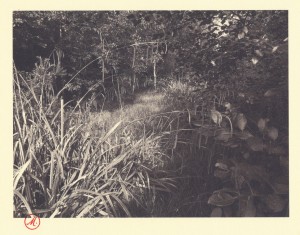 Sometimes I like to print on cartridge or watercolour paper. The effect has the softness and texture of a calotype or gum print. Compared to a print on photo paper, fine detail is attenuated, colours are muted and blacks are less intense. I use white or cream acid-free Seawhite cartridge from the local art shop, and similar results can be had using hot pressed watercolour paper – Fabriano and Saunders Waterford are good. A1 sheets are easily torn to make eight A4s for framing or sixteen A5s – which are very useful to lay-out on a table for editing and sequencing.
Sometimes I like to print on cartridge or watercolour paper. The effect has the softness and texture of a calotype or gum print. Compared to a print on photo paper, fine detail is attenuated, colours are muted and blacks are less intense. I use white or cream acid-free Seawhite cartridge from the local art shop, and similar results can be had using hot pressed watercolour paper – Fabriano and Saunders Waterford are good. A1 sheets are easily torn to make eight A4s for framing or sixteen A5s – which are very useful to lay-out on a table for editing and sequencing.
Squint at some prints through a microscope and you can see why cartridge prints give soft images. Photo paper has a coating which rapidly absorbs the ink droplets and contains them as sharp dots. The uncoated cartridge does not absorb ink quickly, so the droplets splat onto the paper, spreading out into irregular shapes which overlap each other. The colours tend to mix and become diluted.
I have been very happy with the results from my old HP printer and find the best settings to be to set the paper type to “everyday photo paper” and print quality to “best”. But when I tried it with my new Canon iP8750 I found the effect to be quite different. Prints are much sharper and blacks much blacker. The softening effect is much less.
I have yet to perfect photo-microscopy with my primitive equipment so I can’t show any great enlargements, but this composite of scanned prints (at 1200dpi) does show the differences quite clearly. The Canon printer’s ink droplets are much smaller than those that the eight year-old Hewlett-Packard produces. Quite simply they splat and spread much less. So, If you want very soft prints, use an older printer!
While I am on the subject, I find that for this type of print, the best paper type setting for the Canon printer is “Plain Paper”. Use any of the photo paper settings and the dark tones over-ink, forming intense black puddles.
On photo gloss paper, the Canon clearly produces greater detail and subtlety of shading than the HP. Interestingly, that difference is not so very noticeable on prints seen at a normal viewing distance.

